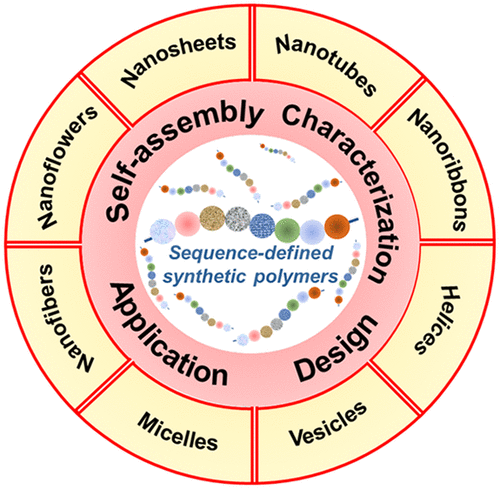当前位置:
X-MOL 学术
›
Chem. Rev.
›
论文详情
Our official English website, www.x-mol.net, welcomes your
feedback! (Note: you will need to create a separate account there.)
Hierarchical Nanomaterials Assembled from Peptoids and Other Sequence-Defined Synthetic Polymers
Chemical Reviews ( IF 51.4 ) Pub Date : 2021-08-03 , DOI: 10.1021/acs.chemrev.1c00024 Zhiliang Li 1, 2 , Bin Cai 1, 3 , Wenchao Yang 1, 4 , Chun-Long Chen 1, 5
Chemical Reviews ( IF 51.4 ) Pub Date : 2021-08-03 , DOI: 10.1021/acs.chemrev.1c00024 Zhiliang Li 1, 2 , Bin Cai 1, 3 , Wenchao Yang 1, 4 , Chun-Long Chen 1, 5
Affiliation

|
In nature, the self-assembly of sequence-specific biopolymers into hierarchical structures plays an essential role in the construction of functional biomaterials. To develop synthetic materials that can mimic and surpass the function of these natural counterparts, various sequence-defined bio- and biomimetic polymers have been developed and exploited as building blocks for hierarchical self-assembly. This review summarizes the recent advances in the molecular self-assembly of hierarchical nanomaterials based on peptoids (or poly-N-substituted glycines) and other sequence-defined synthetic polymers. Modern techniques to monitor the assembly mechanisms and characterize the physicochemical properties of these self-assembly systems are highlighted. In addition, discussions about their potential applications in biomedical sciences and renewable energy are also included. This review aims to highlight essential features of sequence-defined synthetic polymers (e.g., high stability and protein-like high-information content) and how these unique features enable the construction of robust biomimetic functional materials with high programmability and predictability, with an emphasis on peptoids and their self-assembled nanomaterials.
中文翻译:

从类肽和其他序列定义的合成聚合物组装的分层纳米材料
在自然界中,序列特异性生物聚合物自组装成分层结构在功能性生物材料的构建中起着至关重要的作用。为了开发能够模仿和超越这些天然对应物功能的合成材料,已经开发并利用各种序列定义的生物和仿生聚合物作为分层自组装的构建块。本综述总结了基于类肽(或多-N-取代的甘氨酸)和其他序列定义的合成聚合物的分级纳米材料的分子自组装的最新进展。重点介绍了监测组装机制和表征这些自组装系统的物理化学性质的现代技术。此外,还讨论了它们在生物医学科学和可再生能源中的潜在应用。本综述旨在强调序列定义的合成聚合物的基本特征(例如,高稳定性和类似蛋白质的高信息含量)以及这些独特的特征如何能够构建具有高可编程性和可预测性的稳健仿生功能材料,重点是拟肽及其自组装纳米材料。
更新日期:2021-08-03
中文翻译:

从类肽和其他序列定义的合成聚合物组装的分层纳米材料
在自然界中,序列特异性生物聚合物自组装成分层结构在功能性生物材料的构建中起着至关重要的作用。为了开发能够模仿和超越这些天然对应物功能的合成材料,已经开发并利用各种序列定义的生物和仿生聚合物作为分层自组装的构建块。本综述总结了基于类肽(或多-N-取代的甘氨酸)和其他序列定义的合成聚合物的分级纳米材料的分子自组装的最新进展。重点介绍了监测组装机制和表征这些自组装系统的物理化学性质的现代技术。此外,还讨论了它们在生物医学科学和可再生能源中的潜在应用。本综述旨在强调序列定义的合成聚合物的基本特征(例如,高稳定性和类似蛋白质的高信息含量)以及这些独特的特征如何能够构建具有高可编程性和可预测性的稳健仿生功能材料,重点是拟肽及其自组装纳米材料。









































 京公网安备 11010802027423号
京公网安备 11010802027423号